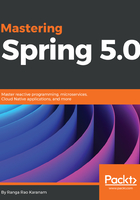
What this book covers
Chapter 1, Evolution to Spring Framework 5.0, takes you through the evolution of the Spring Framework, ranging from its initial versions to Spring 5.0. Initially, Spring was used to develop testable applications using dependency injection and core modules. Recent Spring Projects, such as Spring Boot, Spring Cloud, Spring Cloud Data Flow--deal with application infrastructure and moving applications to Cloud. We get an overview of different Spring modules and projects.
Chapter 2, Dependency Injection, dives deep into dependency injection. We will look at different kinds of dependency injection methods available in Spring, and how auto-wiring makes your life easy. We will also take a quick look into unit testing.
Chapter 3, Building a Web Application with Spring MVC, gives a quick overview of building a web application with Spring MVC.
Chapter 4, Evolution toward Microservices and Cloud-Native Applications, explains the evolution of application architectures in the last decade. We will understand why microservices and Cloud Native applications are needed and get a quick overview of the different Spring projects that help us build Cloud-Native applications.
Chapter 5, Building Microservices with Spring Boot, discusses how Spring Boot takes away the complexity in creating production-grade Spring-based applications. It makes it easy to get started with Spring-based projects and provides easy integration with third-party libraries. In this chapter, we will take the students on a journey with Spring Boot. We will start with implementing a basic web service and then move on to adding caching, exception handling, HATEOAS, and internationalization, while making use of different features from the Spring Framework.
Chapter 6, Extending Microservices, focuses on adding more advanced features to the microservices that we built in Chapter 4, Evolution toward Microservices and Cloud-Native Applications.
Chapter 7, Advanced Spring Boot Features, takes a look at the advanced features in Spring Boot. You will learn how to monitor a microservice with a Spring Boot Actuator. Then, you will deploy the microservice to Cloud. You will also learn how to develop more effectively with the developer tools provided by Spring Boot.
Chapter 8, Spring Data, discusses the Spring Data module. We will develop simple applications to integrate Spring with JPA and Big Data technologies.
Chapter 9, Spring Cloud, discusses the distributed systems in the Cloud that have common problems, configuration management, service discovery, circuit breakers, and intelligent routing. In this chapter, you will learn how Spring Cloud helps you develop solutions for these common patterns. These solutions should work well on the Cloud as well as developer local systems.
Chapter 10, Spring Cloud Data Flow, talks about the Spring Cloud Data Flow, which offers a collection of patterns and best practices for microservices-based distributed streaming and batch data pipelines. In this chapter, we will understand the basics of Spring Cloud Data Flow and use it to build basic data flow use cases.
Chapter 11, Reactive Programming, explores programming with asynchronous data streams. In this chapter, we will understand Reactive programming and take a quick look at the features provided by the Spring Framework.
Chapter 12, Spring Best Practices, helps you understand best practices in developing enterprise applications with Spring related to unit testing, integration testing, maintaining Spring configuration, and more.
Chapter 13,Working with Kotlin in Spring, introduces you to a JVM language gaining quick popularity--Kotlin. We will discuss how to setup a Kotlin project in Eclipse. We will create a new Spring Boot project using Kotlin and implement a couple of basic services with unit and integration testing.